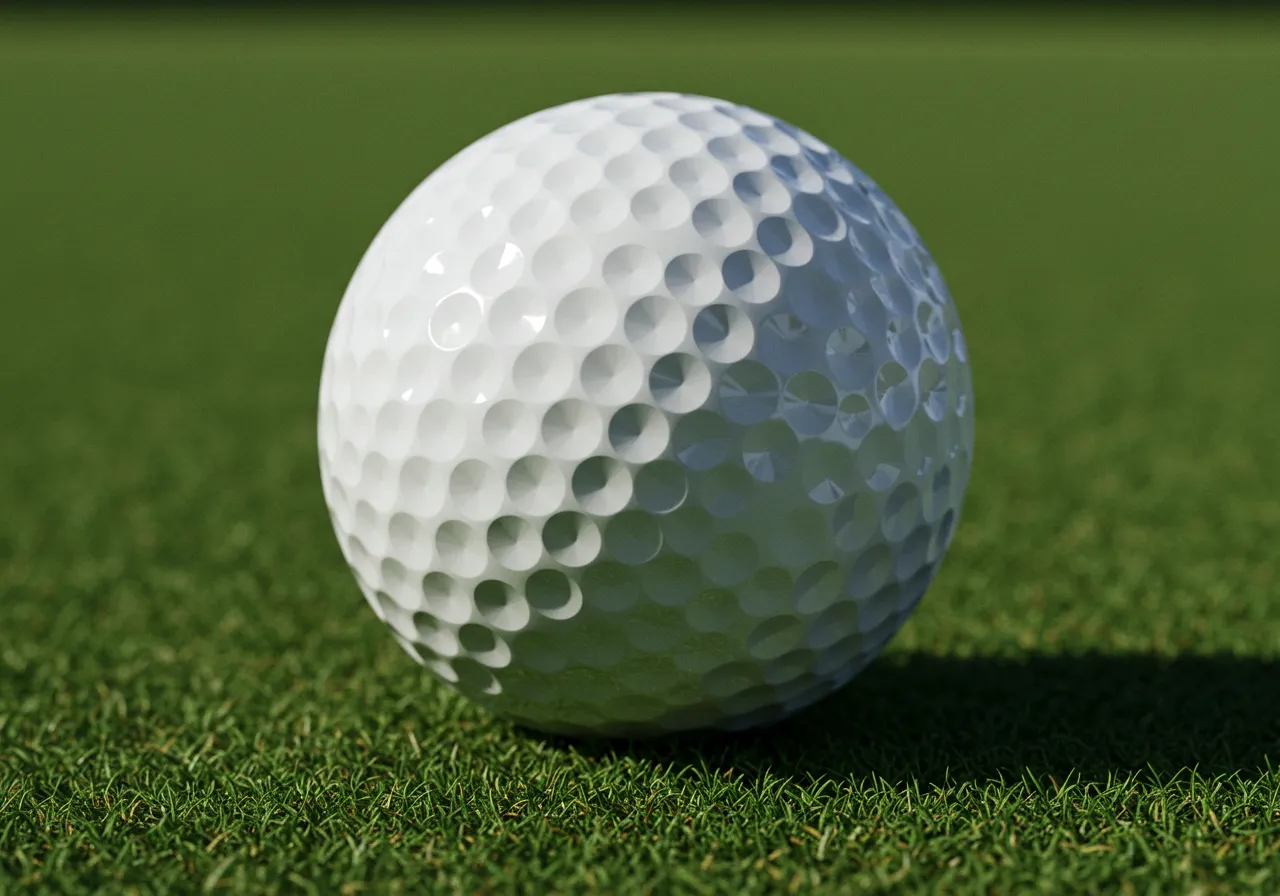Do Golf Balls Make A Difference For Beginners
If you’re new to golf, the right golf ball can help you hit straighter and longer shots with less effort. Beginner golf balls are made with two parts and feel soft. This soft feel helps the ball go farther when you swing slower, which is perfect if you’re just learning to play.
They also reduce sidespin, so you won’t slice the ball as much. Balls like the Callaway Supersoft or Titleist TruFeel are made to help new golfers play better and feel more confident. So yes, golf balls matter, and picking the right one can make a big difference to your game.
In this guide, we’ll delve into do golf balls make a difference for beginners and help you choose the right one to improve your play.
How Do Golf Balls Affect Your Game
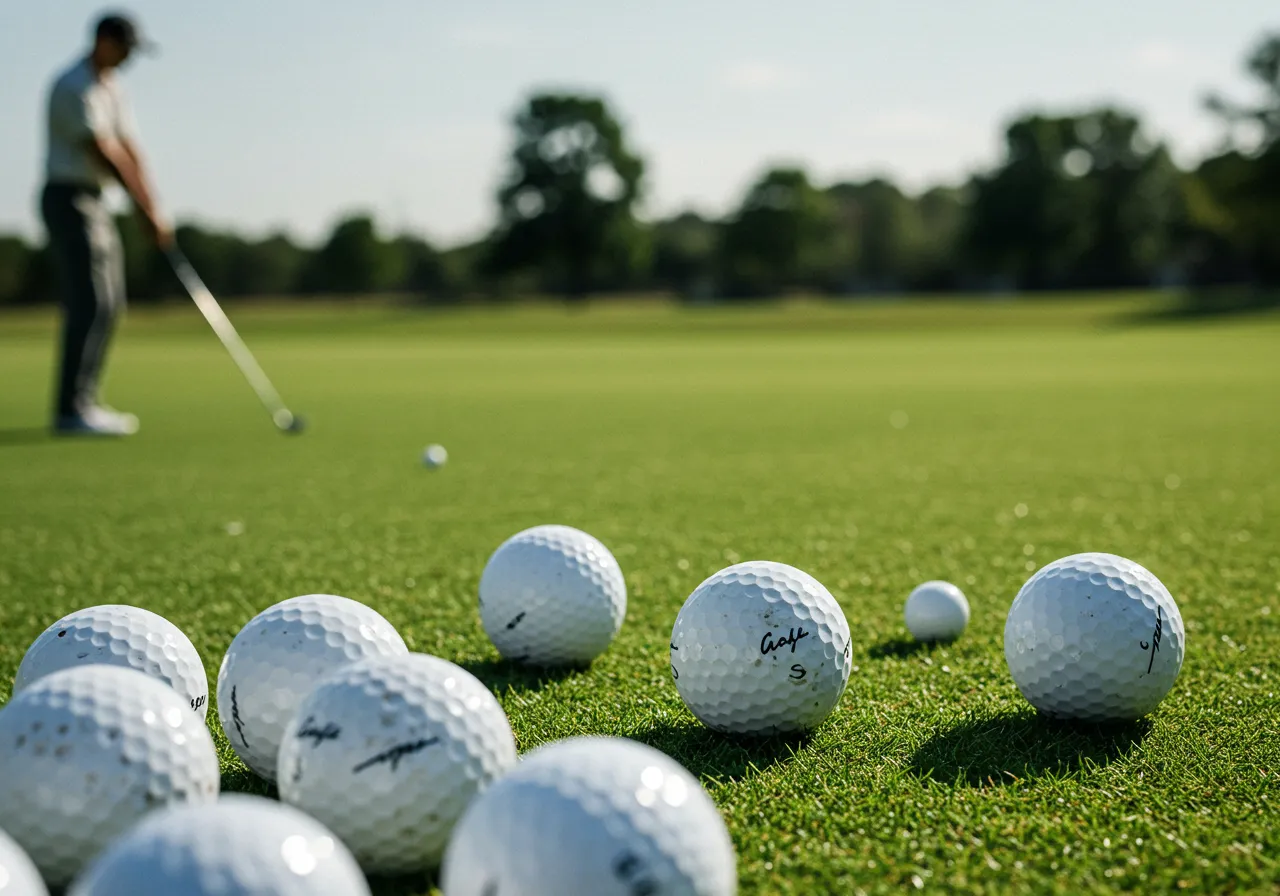
Golf balls can change how well you play. The way a ball is made, like how soft it is, what it’s made of, and the tiny dimples on it, can affect how far it goes, how straight it flies, and how easy it is to control.
For beginners, a soft two-piece ball with a strong cover is best. It helps you hit straighter shots and makes the game easier to learn.
What Are the Differences Between One-Piece, Two-Piece, and Multi-Layer Golf Balls
Golf balls are made in different ways to fit different skill levels. A one-piece golf ball is made from one solid material. It’s cheap and strong, but not great for real games. A two-piece ball features a soft rubber core and a hard cover.
This helps the ball go farther and fly straighter, which is perfect for beginners. Multi-layer golf balls have three or more layers. These balls offer more spin and control, but are designed for experienced players with better swings.
How Do Surlyn and Urethane Golf Ball Covers Make a Difference
The outer cover of a golf ball also matters. Surlyn is a strong plastic that makes the ball last longer. It gives less spin and helps the ball fly straighter.
This is good for new players. Urethane is softer and adds more spin, which helps skilled players control the ball better, especially around the green. But urethane balls are more expensive and easier to damage, so they’re not the best choice when you’re just starting.
How Do Dimple Patterns on Golf Balls Affect Distance and Spin
The small dimples on a golf ball help it move through the air. These dimples reduce air drag and help the ball go higher and farther. They also help the ball stay in the air longer by adding lift. Different dimple patterns can also change how much the ball spins.
Less spin gives a straighter shot, and more spin gives better control. Beginner golf balls usually have simple dimple patterns that help you hit longer and straighter shots more easily.
Table Of Golf Ball Features and How They Affect Your Game
| Feature | What It Means | Best For | Beginner Benefit |
| One-Piece Ball | Solid, cheap, durable | Practice or mini-golf | Not ideal for real games |
| Two-Piece Ball | Rubber core + hard cover | Beginners with slower swing speeds | More distance, straighter shots |
| Multi-Layer Ball | 3+ layers for control and spin | Skilled players | Too advanced for most beginners |
| Surlyn Cover | Hard plastic, very strong | Beginners and casual players | Less spin, more straight shots |
| Urethane Cover | Softer cover, more spin control | Advanced players | Better around greens, but wears out faster |
| Low Compression | The ball squishes more when hit | Slower swing speeds | Easier to hit farther with less power |
| Dimple Pattern | Small dents on the surface | All players | Helps the ball fly higher and farther |
Reference Note:
This table is based on product data and beginner golf ball recommendations from Callaway, Titleist, Golf Monthly, and general golf ball construction guides.
Real models like the Callaway Supersoft, Titleist TruFeel, and Srixon Soft Feel reflect these characteristics and are popular among beginners for their distance, feel, and forgiveness.
What Do Beginners Really Need in a Golf Ball for Playing
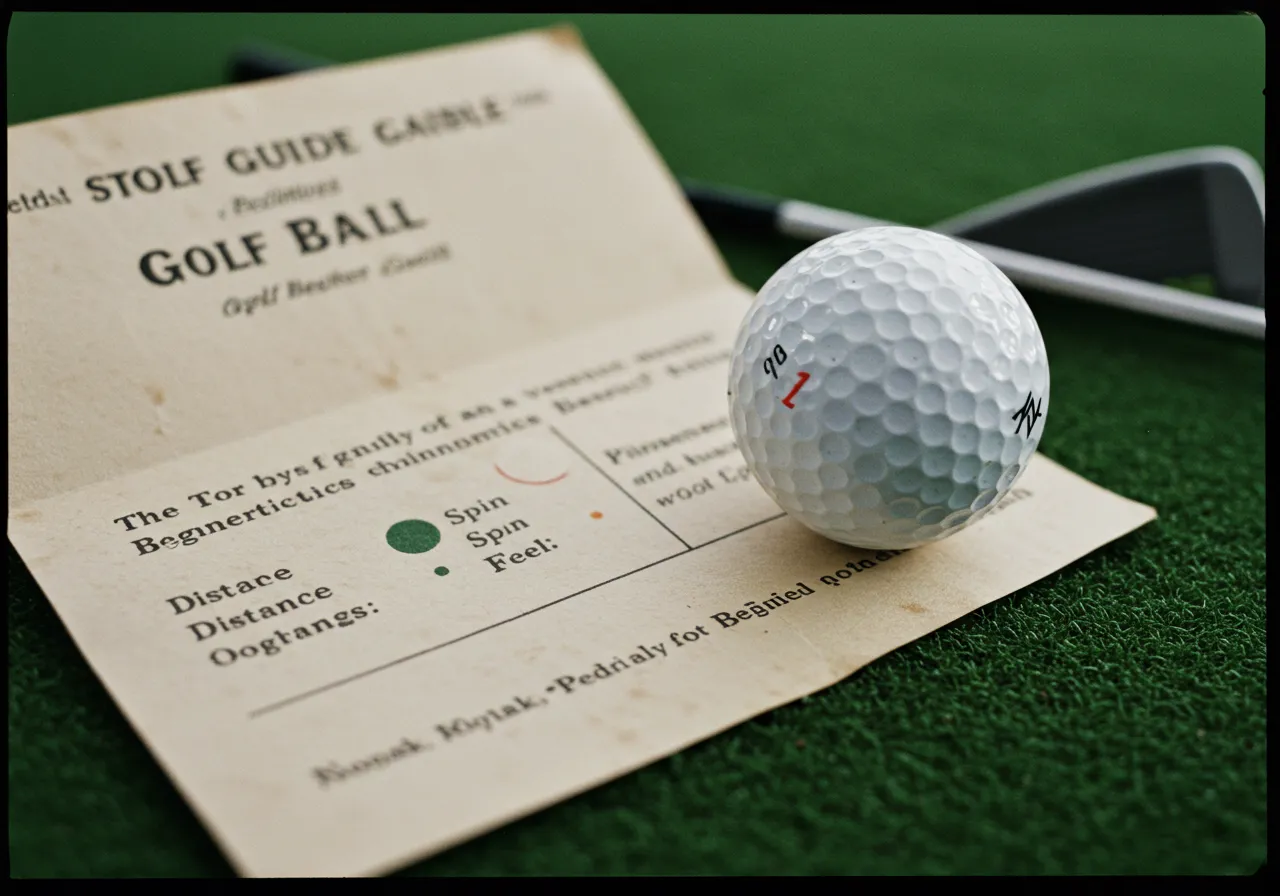
Beginners need a low-compression, two-piece golf ball with a Surlyn cover. This design adds distance, reduces spin for straighter shots, and offers durability with a soft feel for better short game control.
Best Golf Ball for Beginners with Slow Swing Speed to Maximize Distance
Many beginners have slower swing speeds, which makes it harder to hit the ball far. Low-compression golf balls typically rated under 60 are easier to compress at impact, helping players get more distance without extra force.
These balls are designed to launch higher and roll farther, making them ideal for new golfers who need help reaching the fairway or green in fewer strokes.
Low-Spin Golf Balls That Help Beginners Hit Straighter Shots
When you’re just starting out, keeping the ball straight is often more important than shaping shots. Low-spin golf balls reduce sidespin, which helps limit slices and hooks.
This leads to more consistent ball flight and straighter drives, especially for high-handicap players still working on swing mechanics.
Most Durable Golf Ball Cover for Beginners: Surlyn vs. Urethane
Beginners tend to mis-hit more often, so golf ball durability matters. Surlyn-covered golf balls are harder and more resistant to scuffs, cuts, and wear, making them better suited for long-lasting use.
Compared to softer urethane balls, Surlyn models last longer and fly straighter, making them the preferred cover type for new players learning the game.
Why a Soft Feel Golf Ball Improves Putting and Chipping for Beginners
Feel matters most in the short game. Golf balls with a soft feel give better feedback on the green and help with control when putting or chipping.
Many low-compression balls naturally offer this softer touch, which can help beginners gain confidence when hitting delicate shots around the hole.
Affordable Golf Balls for Beginners Who Often Lose Balls on the Course
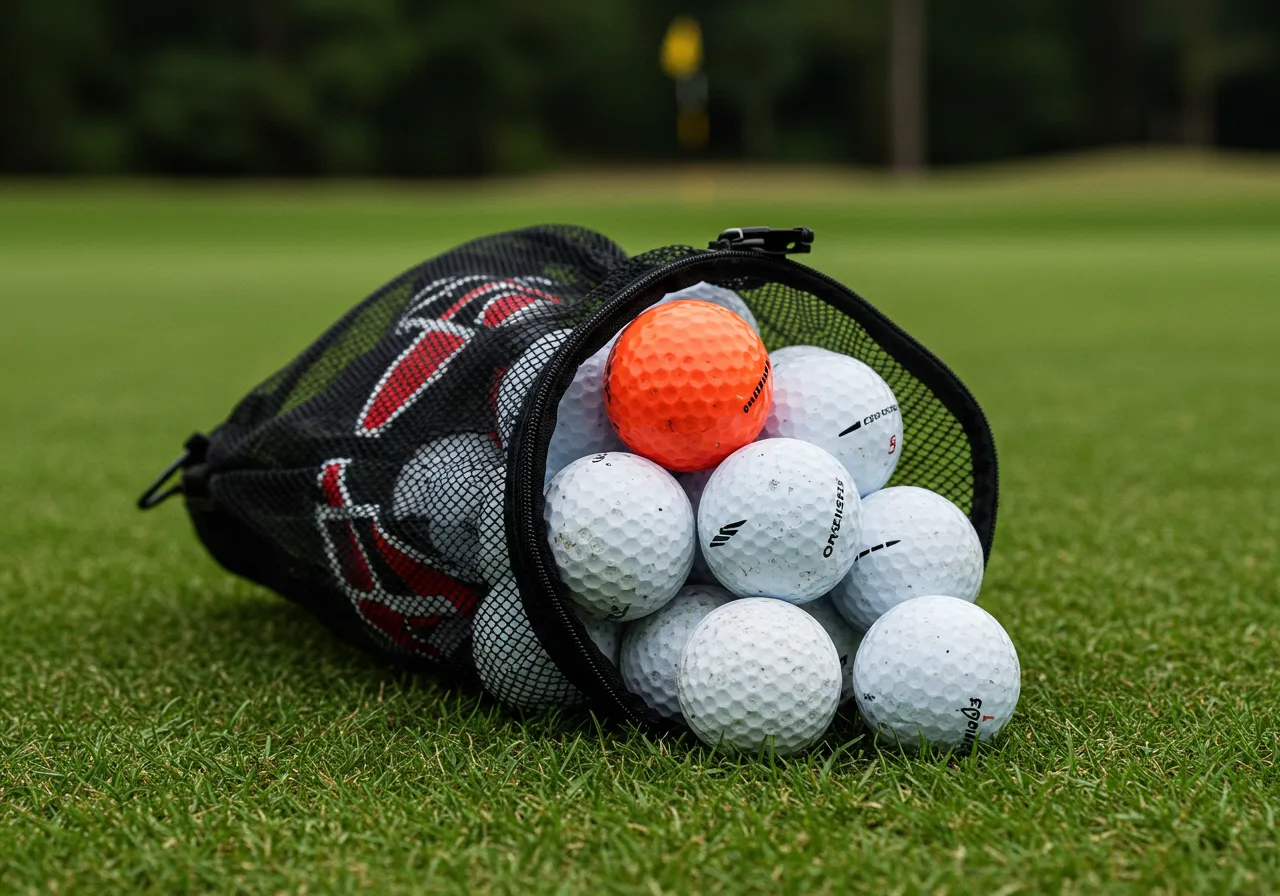
Losing balls is part of learning golf. That’s why cost matters. Premium balls can cost over $4 each, while beginner-friendly options are often under $2 per ball.
Choosing budget-friendly models lets new golfers play and practice without worrying about replacing expensive equipment after every round.
How Do Golf Balls Impact High Handicapper Performance
High handicappers often benefit from golf balls designed to complement their swing characteristics.
Using a low-compression, two-piece ball with a Surlyn cover can help maximize distance and reduce spin, leading to straighter shots. Additionally, a softer feel can improve control in the short game, aiding in better putting and chipping.
Top Golf Ball Features Beneficial for High Handicappers
- Low Compression: Facilitates greater distance for players with slower swing speeds.
- Surlyn Cover: Offers durability and reduces spin for straighter shots.
- Soft Feel: Enhances control around the greens, improving short-game performance.
- Affordability: Cost-effective options allow for consistent play without the worry of losing expensive balls.
Recommended Golf Balls for Beginners Golfers
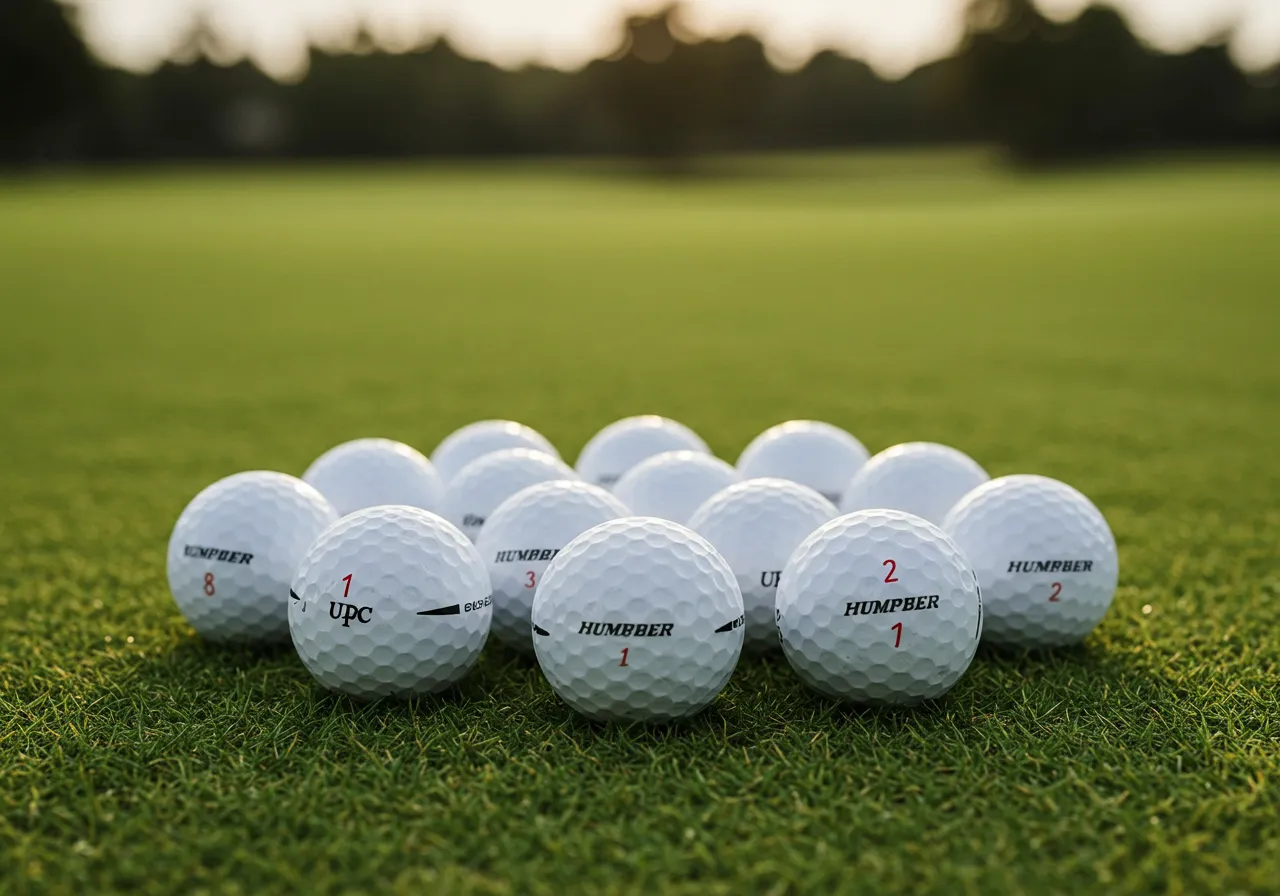
Based on expert reviews and player feedback, here are some golf balls well-suited for high handicappers:
- Callaway Supersoft Golf Ball: Known for its low compression and soft feel, aiding in distance and control.
- Srixon Soft Feel: Offers a balance of distance and soft feel, suitable for slower swing speeds.
- Bridgestone e6: Designed for straight distance and a soft feel, helping reduce slices and hooks.
- TaylorMade Distance+: Provides enhanced distance with a soft feel, beneficial for overall performance.
- Titleist TruFeel: Combines soft feel with reliable distance, aiding in consistent play.
Best Golf Balls for Beginners and High Handicappers: Feature Comparison Table
| Golf Ball | Compression | Cover Material | Key Benefits | Why It’s Good for Beginners and High Handicappers |
| Callaway Supersoft | Low (~38) | Surlyn | Soft feel, high launch, low spin | Easier distance with slow swing speed; very forgiving |
| Srixon Soft Feel | Low (~60) | Ionomer (Surlyn-like) | Balanced distance and soft feel | Good blend of control and forgiveness |
| Bridgestone e6 golf balls | Mid-Low (~50) | Surlyn | Straight distance, reduced sidespin | Helps reduce slices/hooks; very stable flight |
| TaylorMade Distance+ | Low (~60) | Ionomer | Long distance, soft feel, low drag | More carry, less spin = straighter drives |
| Titleist TruFeel | Low (~50) | TruFlex (urethane blend) | Soft feel, responsive around the green | Good short game control with reliable distance |
Reference Note:
Compression ratings and features are based on manufacturer data and user testing reports. These balls are commonly recommended for high handicappers and beginners due to their blend of distance, forgiveness, and feel at an affordable price point.
Types of Golf Balls: What Beginners and Players Need to Know
Golf balls vary by construction, spin, and feel. Beginners should use two-piece, low-compression balls for more distance and straighter shots.
Skilled players often prefer multi-layer balls for better spin and control. Choosing the right type depends on your swing speed, skill level, and shot preference.
Two-Piece Golf Balls for Beginners Who Want Distance and Durability
Two-piece golf balls are made with a strong rubber core and a tough cover, usually Surlyn. These balls are great for beginners because they go far and don’t get damaged easily.
They have low spin, which helps the ball fly straighter. If you’re learning to swing, a two-piece ball gives you more forgiveness and helps build confidence.
Multi-Layer Golf Balls for Players Who Want More Control and Spin
Multi-layer golf balls have three or more layers. These are built for more spin and shot control, especially near the green. They often have soft urethane covers that give a better feel and let skilled players shape their shots.
These balls work best for advanced golfers with faster swings who want to control the ball more, not just hit it far.
Golf Balls Made for Women or Slower Swing Speeds
Some balls are called “lady golf balls,” but they’re really just made for people with slower swing speeds.
These usually have low compression and a soft cover to help the ball go higher and farther without needing a strong swing. They’re also good for seniors and young players. If you want a softer feel and more launch, this type of ball is a great option.
What Kind of Golf Ball Should You Use for Golf Play
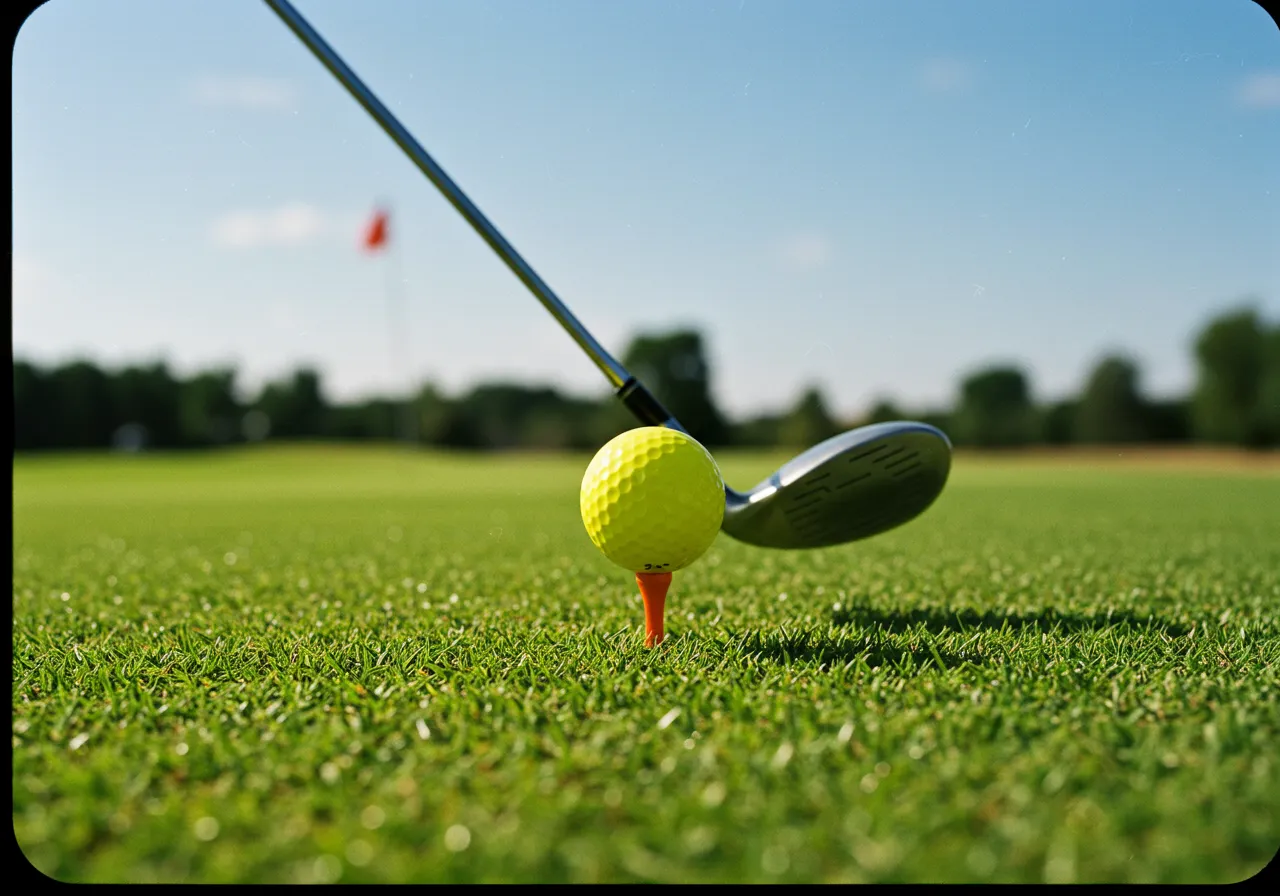
Best Golf Ball Based on Skill Level and Handicap
If you’re new to golf or have a high handicap, use a ball that helps with distance and forgiveness, like a two-piece, low-compression ball.
As your skills grow, you can try balls that give more spin and feel. Low-handicap and skilled players often use multi-layer balls to get more control during tough shots.
How Your Swing Speed Affects Golf Ball Compression
Your swing speed is how fast you hit the ball. If your swing is slow (under 85 mph), use a low-compression ball.
It will go farther with less effort. Mid-speed players (85–105 mph) should try medium-compression balls for a mix of distance and feel. Fast swingers (over 105 mph) need high-compression balls to keep control of their shots.
Matching Golf Ball Feel and Spin to Your Playing Style
If you like hitting long, straight shots, pick a ball with low spin and a firm cover. If you want better control and feel, especially for chipping and putting, go for a ball that has a soft cover and more spin.
Some players want distance, others want control; find what helps your game the most.
Golf Ball Types and Recommendations for Different Players
| Golf Ball Type | Best For | Key Features | Why It’s Good |
| Two-Piece Golf Ball | Beginners and high-handicap players | Low compression, Surlyn cover, low spin | Goes farther, flies straighter, very durable |
| Multi-Layer Golf Ball | Advanced players with fast swing speeds | More layers, soft urethane cover, high spin | Better control, more spin, great for short game |
| Lady Golf Ball | Slower swing speeds (women, seniors, kids) | Low compression, soft feel, higher launch | Easier to hit, adds distance for slower swings |
Note: The comparison reflects how compression, cover material, and layer design influence distance, spin, and feel, especially for different swing speeds and skill levels.
Mistakes Beginners Make When Picking Golf Balls
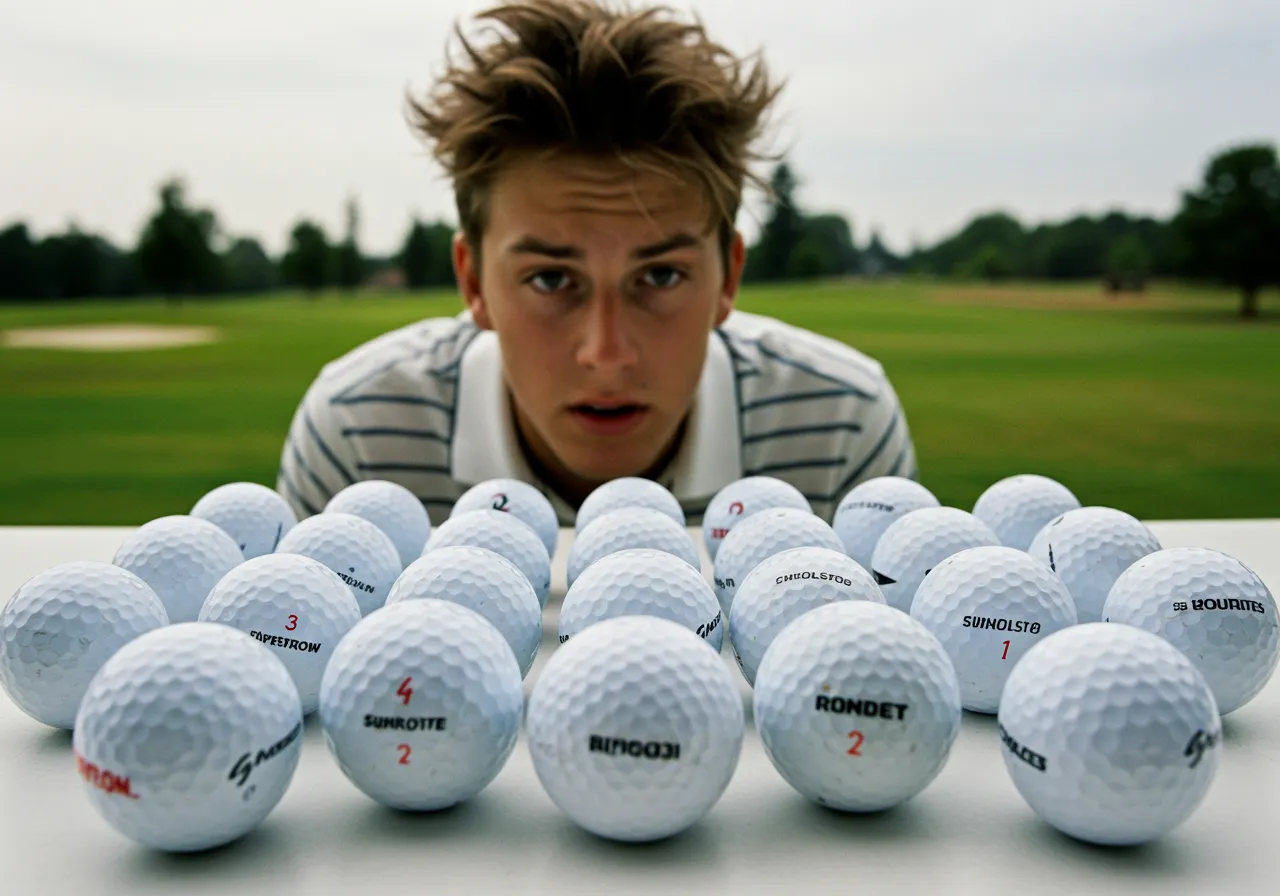
Picking the wrong golf ball can make learning harder. Many beginners choose balls with the wrong compression, ignore short-game feel, or switch brands too often.
Understanding what to avoid helps you pick a ball that gives better distance, control, and consistency.
Choosing Tour-Level Golf Balls Too Early Without Swing Speed to Match
Premium tour balls are made for fast swing speeds and advanced control. These balls often have high compression and generate a lot of spin, which can hurt distance and accuracy if you’re still learning.
Beginners should avoid these until their swing speed and short game are more consistent. A low-compression, two-piece golf ball is a much better choice when starting out.
Changing Golf Ball Brands Too Often Hurts Your Shot Consistency
Every golf ball reacts differently. If you keep switching brands or types, it’s harder to learn how the ball behaves on chips, putts, and drives.
Sticking with one model builds feel and consistency, helping you improve faster and trust your shots.
Ignoring Short Game Feel When Picking a Golf Ball for Control
Many beginners focus only on distance and forget how important feel is during putting and chipping.
Some balls feel too hard off the clubface, making it difficult to control speed and direction. A soft-feel ball can improve your touch and boost confidence in the short game.
Spending Too Much on Golf Balls When You’re Still Losing Them
Beginners often lose multiple balls in a single round. Buying expensive balls too early is not only costly. It’s unnecessary.
Affordable beginner golf balls are made for distance, forgiveness, and durability. They’re ideal while you’re learning and still prone to off-target shots.
Golf Ball Buying Advice for Beginner Golfers

How to Choose the Right Golf Ball: Prioritizing Feel, Distance, and Control
As a beginner, selecting a golf ball that complements your swing speed and skill level is crucial. Key factors to consider include:
- Feel: A softer feel can enhance feedback during putting and chipping.
- Distance: Low-compression balls can help maximize distance for slower swing speeds.
- Control: Balls with lower spin rates can assist in achieving straighter shots.
Starting with a two-piece, low-compression ball can provide a balance of distance and control, aiding in building confidence on the course
Best Golf Balls for Beginners Under $25 per Dozen
For those seeking quality golf balls without a hefty price tag, consider the following options:
- Srixon Soft Feel: Offers a soft feel with impressive distance and durability.
- Callaway Supersoft: Known for its ultra-soft feel and straight flight path.
- Bridgestone e6: Designed for straight distance and a soft feel, aiding in reducing slices and hooks.
- Wilson Duo Soft+: Provides a low-compression core for enhanced distance and a soft feel.
These balls are tailored to assist beginners in achieving better performance without overspending.
Found Balls vs. New Balls: Is It Worth Buying Premium
Utilizing found or used golf balls can be a cost-effective approach for beginners. High-grade used balls often perform comparably to new ones, especially for those still developing their skills.
However, it’s advisable to avoid refurbished balls, as the refinishing process can alter the ball’s performance characteristics. Once consistency and skill improve, investing in new, premium balls may offer additional benefits.
Faqs
How often should beginners change their golf balls?
Beginners should change their golf balls every few rounds or when noticeable damage occurs. Regularly changing balls ensures consistent performance and prevents the use of worn-out balls that can negatively impact the game.
- Durability: Two-piece balls tend to last longer, making them ideal for beginners.
• Signs of Wear: Look for scuffs, cuts, or loss of dimples as indicators for changing the ball.
Do premium golf balls make a significant difference for beginners?
Premium golf balls offer advanced features like higher spin rates and better control, but they may not provide noticeable benefits for beginners. Beginners should focus on finding a ball that matches their skill level and swing speed.
- Cost vs. Benefit: Premium balls are more expensive and may not justify the cost for beginners.
• Skill Development: Using affordable balls allows beginners to focus on improving their skills without worrying about losing expensive balls.
What Compression Rating Golf Ball Is Best for Beginners with Slow Swing Speeds?
Beginners with slower swing speeds (under 85 mph) should use low-compression golf balls, typically rated between 30 and 60. These balls compress more easily when hit, which helps create more distance with less effort. Low-compression balls also feel softer, giving better feedback during the short game.
Should a Beginner Golfer Use a Soft or Hard Golf Ball for Better Control?
Soft golf balls are usually the best choice for beginners. They offer a better feel on chips and putts and are easier to compress, especially with slower swings. Hard golf balls are more durable but often harder to control. If you’re learning, a soft, low-compression ball helps with both distance and short-game control.
Can Using the Wrong Golf Ball Affect a Beginner’s Game Performance?
Yes, using the wrong golf ball can hurt your game. A ball that’s too hard or too advanced may reduce distance, add unwanted spin, or feel too firm on short shots. Choosing a beginner-friendly golf ball matched to your swing speed and skill level makes learning easier and more fun.
How Many Golf Balls Should a Beginner Carry During a Round of Golf?
It’s smart for beginners to carry at least 9 to 12 golf balls during a round. Since beginners may lose balls more often, having extras prevents running out mid-game. Use affordable two-piece balls so you can practice freely without worrying about the cost of replacements.
Conclusion: Choosing the Right Golf Ball Makes a Big Difference for Beginners
Picking the right golf ball is one of the easiest ways to improve your game as a beginner. You don’t need a tour-level ball you need a ball that matches your swing speed and helps you hit straighter, longer shots.
Look for a two-piece ball with low compression, a Surlyn cover, and a soft feel. These features add distance, reduce spin, and give you better control around the green.
Stay consistent with one ball type and focus on building your skill, not chasing brand names.
Tested CHEAP vs EXPENSIVE Golf Balls
Posts References:
How big a difference do balls make
Do Golf Balls Make a Difference
